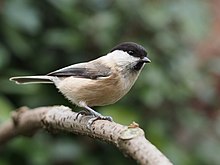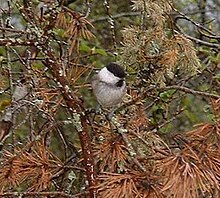Willow tit
| Willow tit | ||||||||||||
|---|---|---|---|---|---|---|---|---|---|---|---|---|

Willow tit ( Poecile montanus ) |
||||||||||||
| Systematics | ||||||||||||
|
||||||||||||
| Scientific name | ||||||||||||
| Poecile montanus | ||||||||||||
| ( Conrad von Baldenstein , 1827) |
The willow tit or monk tit ( Poecile montanus , syn .: Parus montanus , in Latin montanus , belonging to the mountain) is a species of bird in the tit family (Paridae). In Central Europe this species of titmouse is a widespread and sometimes very frequent breeding and annual bird.
External characteristics and singing
The willow tit is almost twelve centimeters long. The headstock, neck and chin area are black and not shiny. The cheeks are pure white up to the neck. The back is gray-brown and the belly is whitish. This species also differs from the very similar marsh tit in its external appearance by the larger black chin field and a clearly recognizable light field on the wings.
The willow tit's call is characteristic and sounds like a broad squashed “dääh”, sometimes also “zizidäääh”. The singing consists of five to six descending - therefore melancholic - whistling sounds "dju-dju-dju-dju-dju".
ecology
Distribution area
The willow tit is a breeding bird of the boreal and temperate zones as well as the mountainous regions of the Palearctic. Their distribution area extends from Great Britain and the east of France to the Pacific coast. The species also colonizes Japan. The southern limit of distribution in Europe is the southern edge of the Alps. There are also island-like occurrences in the Abruzzo, the Dinaric Mountains, the Carpathian Arc and the Rhodope Mountains .
The willow tit is a resident bird that usually overwinters in the breeding area.
nutrition
The willow tit feeds on small insects and arachnids , supplemented in winter by high-fat seeds . The diet also includes pollen from willow and quivering aspen and the sap from maple and birch . The animals collect supplies and hide them under the tree bark or between mosses and lichens .
habitat
The species breeds in younger mixed forests , alder swamps , swampy areas with thickets, and prefers generally moist areas with rotten woody plants . The distribution of the species ranges from eastern Western Europe across northern and central Europe to eastern Siberia and Japan .
Breeding biology

The willow tit often builds its own nesting holes in rotten trees . The nest consists of animal hair, plant fibers, moss and rotten wood chips. The female incubates seven to nine eggs for a good 14 days. The hatched nestlings are fed by both parents in the nest for 16 to 19 days.
Duration
The population of the willow tit is estimated at 5 to 6 million breeding pairs in Europe. The main distribution center is Russia, where between twenty and thirty-five million breeding pairs occur. In Central Europe there are only between 600,000 and 1.2 million breeding pairs.
As with other tit species, there can be significant short-term fluctuations in the population. These are usually the result of very harsh winters. In parts of Central Europe in the 20th century, there were sometimes very significant expansions and inventory increases. The species benefited from an increase in coniferous wood planting, the decline in the need for firewood, a fundamentally lower thinning and forest maintenance as well as an increasing number of nesting sites.
literature
- Hans-Günther Bauer, Einhard Bezzel and Wolfgang Fiedler (eds.): The compendium of birds in Central Europe: Everything about biology, endangerment and protection. Volume 2: Passeriformes - passerine birds. Aula-Verlag Wiebelsheim, Wiesbaden 2005, ISBN 3-89104-648-0 .
- Urs N. Glutz von Blotzheim (Hrsg.): Handbook of the birds of Central Europe . Edited by Urs N. Glutz von Blotzheim and Kurt M. Bauer, among others. Volume 13 / I, Passeriformes (4th part), Muscicapidae - Paridae . Aula-Verlag, Wiesbaden 1993, pp. 419-482. ISBN 3-89104-022-9 .
Web links
- Poecile montanus in the endangered Red List species the IUCN 2008. Posted by: BirdLife International, 2004. Retrieved on January 25 of 2009.
- Videos, photos and sound recordings on Poecile montana in the Internet Bird Collection
- Entry at the Swiss Ornithological Institute
- Willow tit feathers
Single receipts
- ↑ Gosler, A., Clement, P. & Garcia, EFJ (2019). Willow Tit (Poecile montanus). In: del Hoyo, J., Elliott, A., Sargatal, J., Christie, DA & de Juana, E. (eds.). Handbook of the Birds of the World Alive. Lynx Edicions, Barcelona. (accessed on https://www.hbw.com/node/59860 on July 24, 2019).
- ↑ Bauer et al., P. 120


